What’s normal at a Parisian restaurant?
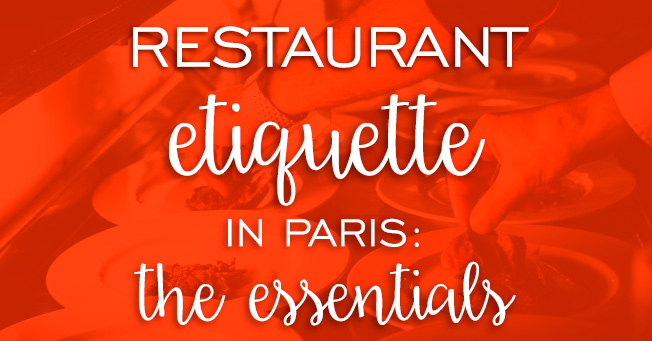
You’ve heard it, I’m sure.
Paris restaurants are awful! The food takes too long! Servers aren’t friendly! It’s expensive!
Yep. Paris has a pretty bad rap.
I promise you though, this is not always the case. In fact, it’s rarely the case that dining is truly bad in Paris (especially if you know how to avoid tourist traps). It’s simply that dining here is different.
But there’s absolutely no reason to be afraid! With an open mind to a few key cultural points, you’re going to be able to avoid any bad dining experience.
Like other cultural differences such as language, work-life balance, fashion, and so on… eating can sometimes be a shock in France.
This is everything you need to know to have the best possible experience at a French restaurant in Paris.
.
1. Waiting
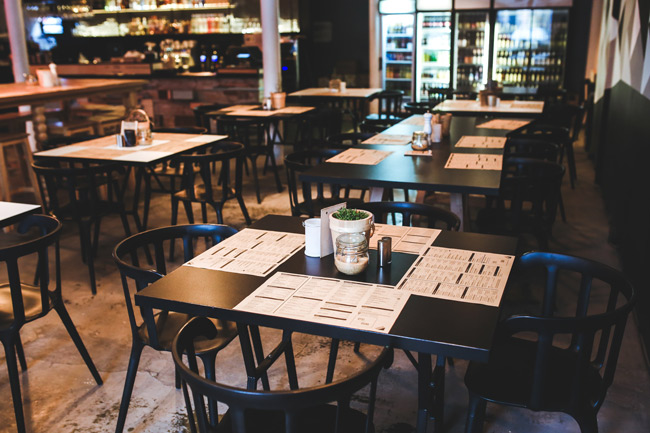
This is probably something you’ve already heard: “everything just takes so long there!”. That’s not totally wrong, actually. The French often have a more laid-back, less rushed approach to things.
Oh, sure: more and more you’re seeing the North-American-style on-the-go Parisian running hurridly from one appointment to the next, Starbucks in one hand and a half-eaten sandwich in the other. But in a general sense, they take things a bit easier on a day to day basis. They’re not afraid to see something take a bit more time.
One thing that definitely takes more time here? Dining out.
Here’s what you need to be prepared for: a typical dinner in Paris takes upwards of 2.5-3 hours (for 3-5 courses). Lunch, if you do it the French way, can take around 1.5 hours.
That might seem like a lot. Food is extremely important to the culture here, and as such: sitting down to a meal is a Big Deal – even when it’s not a big deal. The meal is a moment of connection. It’s not just about the food (though of course it’s about that too). It’s about the conversation, the spending time together, the sharing of little thoughts and deep thoughts alike.
So when the French sit down at a restaurant, those are the things they’re interested in. They don’t want to be hurried into making a decision about wine, or what they’ll eat… and they certainly don’t want to be hurried out of the restaurant the moment the take their final bite of dessert.
The servers understand this, too. Servers in most Parisian restaurants (cafes and brasseries are sometimes different) aren’t working for tips but that doesn’t mean they are bad servers. More on this in another section, but it’s important to understand that the servers are giving patrons the time they want. They’re providing the non-rushed, relaxing environment – or trying to!
Of course there are exceptions, there are always exceptions. But generally, once you’re in the price range of about 50 euros per person and up… you’re going to have a nice, unhurried meal.
You’re going to wait to order your food. You’ll wait more for your drinks to be brought to you (sometimes you’ll wonder to yourself if they are actually BREWING the beer back there). You’ll wait between courses – typically, the nicer the restaurant the longer the wait.
Oh and yes: you will wait for the check.
And you will keep waiting, until you ask for it.
That’s simply how it works here. Having the check dropped off sends a signal to wrap things up. Generally speaking, the French aren’t interested in being told to “wrap it up” when they are digesting a fabulous meal and enjoying their post-dessert digestif.
If you go into your Parisian restaurant experience knowing that it will take longer than what you might be used to, this is going to relieve a huge part of the tension some people experience from the culture shock of dining in France.
.
2. Dress

You’ve heard it too: “The French are such snobs“.
Sometimes, it’s really difficult to refute that. I’m going to try to walk a fine line here…
What you wear into a restaurant in Paris can sometimes impact your experience.
Most restaurants in Paris are what Parisians would consider ‘casual’ – jacket & tie are very rarely required. However, casual in Paris is a notch or two above casual in many other parts of the world, for example the USA where wearing sweatpants to a casual restaurant is not out of the question.
Okay, okay: maybe not sweatpants.
When I’m planning Paris vacations for clients, many clients over the years have asked me what kind of clothing they should wear while sightseeing and more importantly: in Parisian restaurants. At first I was really vague, not wanting to put too fine a point on things or “dress” my clients.
But 6 years of experience has taught me that – at least on this question – people want specifics. So here we go:
- Dark bottoms: jeans (slacks are better) or skirt/dress. Light washed and trendy ripped jeans will likely make you feel out of place
- A nice top. Button-up, sweater, I’m not even sure how to call the different kinds of ‘nice tops’ that are out there. Just know that t-shirts are reserved for Parisians who are on their way to the gym (or combined with a nice blazer in younger crowds).
- Non-gymshoes are key.
I know. I know, you’ve been on your feet walking all day, of course you’re wearing gym shoes. And you can! But if you ask my advice, I’d tell you to switch them out for a nicer, clean pair of shoes for your dinner.
It is a little sad, but at restaurants (not just in Paris, but all over the world), books are often judged by their covers and you occasionally might find that you receive slightly better service if you are dressed nicer.
Paris has a reputation as being one of the best-dressed cities in the world. It’s not so bad to embrace that for a couple days, is it!
.
3. Ordering food

Listen, you do not have to speak perfect French to order food at a restaurant here. In fact, I’m not even really talking about the actual act of telling the server what you want to eat. This section is more about understanding different meal options at restaurants.
It is extremely commonplace for restaurants to offer a formule as well as an à la carte option. These are words to look for! Sometimes formule is just called menu (as in: Menu à 25 euros). Confusing for us English-speakers, I know.
A formule is a set-price menu with multiple course, and several options for each course. Often, you’ll have differently priced formules based on the dishes each offers, or even based on how many courses you get.
First, you’ll decide which formule you’re going to go for (base it on price, or the options you like better, or how hungry you are). Then, choose one dish from your given options for each course.
Don’t expect the restaurant to substitute items into your chosen formule. If you don’t like the options that are given, you can order à la carte instead (choosing anything off the entire menu). That is sometimes a bit pricier but you have full control.
Back to the formule. Typically you’ll indicate your starter(s) and main dish(es) to your server along with your drink choice. It’s rare that a restaurant will push you to decide on a dessert at the beginning of the meal. Often if I’m asked to decide, I’ll simply tell the server I haven’t chosen yet and prefer to choose after the main course.
Maybe if my confit de canard is extra rich and filling, I won’t want that chocolate mousse after all, and I’d go for the fresh fruits.
Just kidding: never, ever say no to a chocolate mousse. Ever.
If you go to a very fancy restaurant, you may not even get a menu at all. Some restaurants offer a fixed menu, chef’s choice. You can indicate to your server any food aversions or allergies, and then… well, you get what the chef makes you and that’s that.
In these places, the chefs are always magnificent, so there’s not much to worry about. The surprise is part of the fun!
The act of ordering your food or drink might have to start with you getting your server’s attention, by the way. It depends on the restaurant, how busy they are, and many other factors. Don’t feel bad about hailing down your server! That just makes you more French.
.
4. Allergies
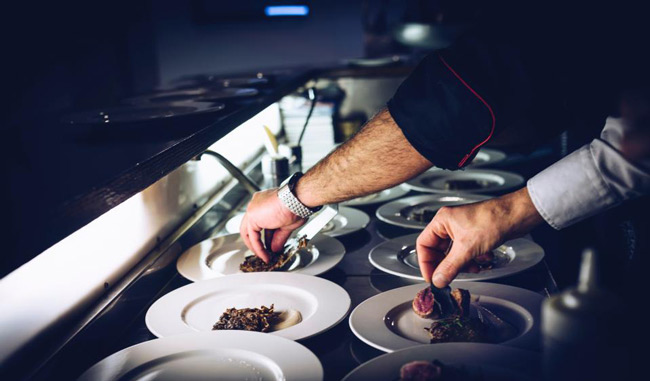
Fewer French have food allergies. (Say that five times fast).
As a quick comparison, about 2.3 million French people have food allergies, versus over 13 million Americans. That’s a huge difference! And it changes the way restaurants typically handle “special requests”. Depending on how severe your allergy is, this could have a big effect on you.
Since there are far less French with allergies, restaurants are less often presented with the opportunity to cater to those diners. They’re simply not used to it.
When you combine that with the fact that many French chefs are purists, you can run into some issues. By purist here, I mean that you won’t even find salt and pepper on the table because in the chef’s eyes, you should eat what he/she prepared, exactly how he/she prepared it. This isn’t an uncommon way of thinking for high-end chefs all over the world, of course. But it seems especially prevalent in France.
That’s why food substitutions aren’t very common in France (see the next point, I’ll get into this a bit more).
So what should you do if you have food allergies?
- Check the restaurant’s website to scope out their menu. Don’t see a single thing on there you can eat? Best to find a new spot for your meal.
- Since many French restaurants change menus quite ofte, if the restaurant passes Step 1, it’s still a good idea to call in order to verify that current menu items fit into your diet. Get help with these calls if you need!
- Depending on the severity of your allergy and your level of French, it could be a good idea to write out the following note to show directly to your server prior to your meal (even if you’d previously called to check):
- J’ai une allergie à [insert French translation of food you’re allergic to]. Est-ce que cela pose un problème ?
There’s an influx of vegetarian, vegan, and gluten-free restaurants in Paris. These places are likely to be a bit more ready to work with food allergies, so that’s another consideration!
.
5. Menu substitutions
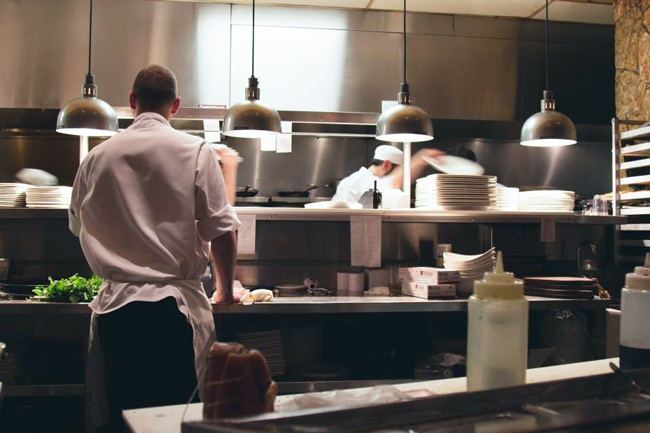
As discussed a bit earlier, French chefs are not always enthusiastic about substitutions. Here I’m talking about individual ingredients of a dish, not a formule course substitution as I discussed above.
Let’s get into it: ingredient substitutions. It’s always worth asking, of course! But you may not get a positive response to a request like “this sandwich but with extra cheese instead of ham, light on the sauce, and add mushrooms”.
French food – especially at better restaurants – tends to be served with the idea that it should be perfect when it arrives in front of you. From seasoning to temperature to appearance, it shouldn’t need anything extra. That’s why you’ll often notice the absense of salt and pepper shakers on the table!
The same applies for condiments – if a steak is meant to be served with mustard (or – *gasp* – ketchup), it will be there on the plate.
There’s this strange sort of cultural flip at restaurants – at least as a North American, you will probabaly recognize it. And that flip is: the chef is always right (not the customer!). In fact it can even be viewed as disrespectful to make substitutions, because you’re not trusting your chef to know his/her profession.
That said, it’s not like you can’t make requests (especially if you have allergies; see above). You certainly can. This section is simply to help you understand why you make get a strange look or even a “no, I’m sorry that’s not possible” if you do ask.
It’s a different world out there – but the more you know about the reasons behind it, the less likely it will be that this strikes you as mean or rude.
.
6. Tipping
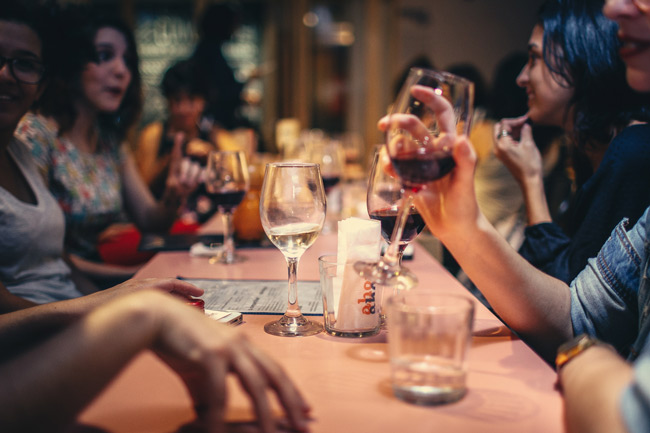
Every traveler wonders this, and you’re probably no different.
What exactly is the tipping policy at restaurants in Paris?
You’ll hear that there’s no tipping, and sometimes of course this happens. However, it’s pretty rare for a French person to go out with friends or family for a nice meal, and not leave any tip for the server.
Of course, you’re not looking at a 20% tip, as is the norm in North America.
However the Frech will typically round up. That means if the bill comes to 47 euros, they’ll leave 50 euros. If it comes to 118 euros, they’ll leave 125 euros.
There’s really no steadfast rule here. However it is important to note that the “No need to leave a tip in France” isn’t really accurate. Tipping is definitely appreciated, and if you have a good experience or enjoyed the food it’s totally normal. (Though again, that 20% tip is not necessary.
Service of course has a different style in France, and a different meaning (see Waiting, above… and Rudeness, below). Servers aren’t going to lather you with (frankly: fake) attention to try to squeeze a few bucks out of you. This can be a good thing, believe me! There’s only so many times you can be asked “how is everything?” with food in your mouth before you’ve had enough.
.
7. Bad service
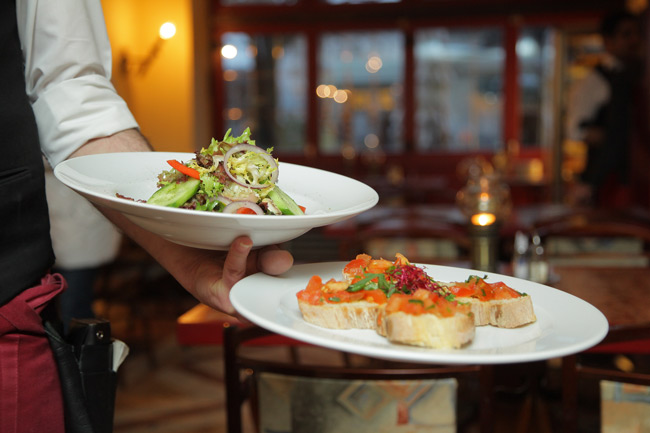
Ah, finally we’ve arrived at the real juicy stuff: the stereotype of terrible service and rude servers in Paris.
Like any stereotype, there are grains of truth here. Some people are just snobby and mean, no matter what job they have.
But it’s really not what you think.
I talked about waiting times in Parisian restaurants a little bit earlier in this article. To reiterate that – a server’s job in France is not to rush you through your meal so they can “turn tables” faster and make more tips (and more money for the restaurant).
A server’s job is to take your order, bring you the things you want, and collect your payment when you’re ready. Being waited on hand-and-foot is pretty rare in Paris.
I think a lot of times, this relative lack of attention is one of the things that makes travelers feel the service is bad or rude.
Another big cultural difference: French servers will not try to get to know you. Having worked as a server for years in the US, that get-to-know-your-customer tactic was something we were trained on. The more you build rapport with your customer, we were told, the better experience in the restaurant and the better tips! The customer should be your best friend!
That is definitely not the case in Paris. So again, coming from the above atmosphere and arriving in France, the difference can seem very stark and very cold.
It’s useful to keep in mind that the goal of the servers here is to make sure you have the food and drink you want, and that you can enjoy your meal and your company in peace. If you need something (if you’re out of water or there’s a problem with your dish for example), chances are you will have to get your server’s attention in order to let them know. If you are waiting around for them to check up on you… you’re probably going to be waiting a long time. And in all likelihood, you’ll get more and more upset/angry/frustrated in that time. This will most certainly lead to feeling that the entire experience was terrible, which of course it’s our goal to avoid.
.
CONCLUSION
Eating out in Paris can be a culture shock. It’s not just the rich food – it’s the atmosphere itself.
But when you know what to expect (and why), the experience can become much less shocking. Arm yourself with knowledge, as they say… you’ll enjoy your restaurant adventures much more that way.
What experiences have you had at Parisian restaurants?
Have we missed any big ideas here?
Let us know in the comments below!
.

The comparison you make between the number of people with allergies in France and in the US isn’t fair. France has a population of about 67 million, while the US has a population of about 327 million. It would be more fair to compare the relative rate of allergies per 100,000 inhabitants. This is a standard practice of academic institutions in order to fairly compare the prevalence of diseases over time as population levels change and between countries of different population sizes. Assuming the numbers you provided are correct, there are 3,433 people out of every 100,000 in France with allergies, and 3,976 people out of every 100,000 in the US. So, relatively speaking allergies are more prevalent in the US than in France, but the difference isn’t as large as you insinuate.
Hi Matt, thanks for reading, and for providing this insight! You’re right in that the difference isn’t as large as we stated if we keep in mind population sizes, but we think it should be stated regardless.
I never knew that allergies are more common among Americans than they are among the French. It makes sense that restaurants would be less used to catering to specific requests since they aren’t often exposed to allergy issues. My husband has quite a list of food allergies, so we’ll definitely have to check menus beforehand. Thanks for the tip!
No problem, Shayla! Thanks for reading 🙂
Hello everybody I’m Valentin from Brest in brittany! Paris is wonderful and its cuisine is a real jawdropper! ;p I know this Blog is mostly about our capital yet I would like to give you a link about an article, it talks about the other region and their culinary culture 🙂 I’m sure you will like it ! Thanks for your blog and bonne journée !
Thanks Valentin! We’d love to read your blog!
I really appreciate your reminder of how the servers are also trying to promote a relaxed and enjoyable environment. My wife and I have been thinking of going out for our anniversary this weekend, and my wife really likes to go out and eat. Since it is our anniversary, I will be sure to find a place that promotes a relaxed environment!
We’re so happy to help! Enjoy your anniversary!
One thing I really like about French restaurants is their menu covers designs which are really out of the world.
That’s awesome, Dennis! Is there one restaurant’s menu you’re thinking of in particular?